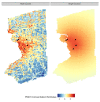The Impact of Individual Mobility on Long-Term Exposure to Ambient PM2.5: Assessing Effect Modification by Travel Patterns and Spatial Variability of PM2.5
- PMID: 33672290
- PMCID: PMC7926665
- DOI: 10.3390/ijerph18042194
The Impact of Individual Mobility on Long-Term Exposure to Ambient PM2.5: Assessing Effect Modification by Travel Patterns and Spatial Variability of PM2.5
Abstract
The impact of individuals' mobility on the degree of error in estimates of exposure to ambient PM2.5 concentrations is increasingly reported in the literature. However, the degree to which accounting for mobility reduces error likely varies as a function of two related factors-individuals' routine travel patterns and the local variations of air pollution fields. We investigated whether individuals' routine travel patterns moderate the impact of mobility on individual long-term exposure assessment. Here, we have used real-world time-activity data collected from 2013 participants in Erie/Niagara counties, New York, USA, matched with daily PM2.5 predictions obtained from two spatial exposure models. We further examined the role of the spatiotemporal representation of ambient PM2.5 as a second moderator in the relationship between an individual's mobility and the exposure measurement error using a random effect model. We found that the effect of mobility on the long-term exposure estimates was significant, but that this effect was modified by individuals' routine travel patterns. Further, this effect modification was pronounced when the local variations of ambient PM2.5 concentrations were captured from multiple sources of air pollution data ('a multi-sourced exposure model'). In contrast, the mobility effect and its modification were not detected when ambient PM2.5 concentration was estimated solely from sparse monitoring data ('a single-sourced exposure model'). This study showed that there was a significant association between individuals' mobility and the long-term exposure measurement error. However, the effect could be modified by individuals' routine travel patterns and the error-prone representation of spatiotemporal variability of PM2.5.
Keywords: long-term exposure to ambient PM2.5; mobility-based approach; routine travel patterns; spatial exposure models; uncertainty.
Conflict of interest statement
The authors declare no conflict of interest.
Figures




Similar articles
-
Assessment and statistical modeling of the relationship between remotely sensed aerosol optical depth and PM2.5 in the eastern United States.Res Rep Health Eff Inst. 2012 May;(167):5-83; discussion 85-91. Res Rep Health Eff Inst. 2012. PMID: 22838153
-
Mortality-Air Pollution Associations in Low Exposure Environments (MAPLE): Phase 2.Res Rep Health Eff Inst. 2022 Jul;2022(212):1-91. Res Rep Health Eff Inst. 2022. PMID: 36224709 Free PMC article.
-
Mortality and Morbidity Effects of Long-Term Exposure to Low-Level PM2.5, BC, NO2, and O3: An Analysis of European Cohorts in the ELAPSE Project.Res Rep Health Eff Inst. 2021 Sep;2021(208):1-127. Res Rep Health Eff Inst. 2021. PMID: 36106702 Free PMC article.
-
Personal and ambient exposures to air toxics in Camden, New Jersey.Res Rep Health Eff Inst. 2011 Aug;(160):3-127; discussion 129-51. Res Rep Health Eff Inst. 2011. PMID: 22097188
-
A review and analysis of personal and ambient PM2.5 measurements: Implications for epidemiology studies.Environ Res. 2022 Mar;204(Pt B):112019. doi: 10.1016/j.envres.2021.112019. Epub 2021 Sep 14. Environ Res. 2022. PMID: 34534524 Review.
Cited by
-
Association of ambient PM2.5 concentration with tuberculosis reactivation diseases-an integrated spatio-temporal analysis.IJID Reg. 2023 Aug 10;8:145-152. doi: 10.1016/j.ijregi.2023.08.001. eCollection 2023 Sep. IJID Reg. 2023. PMID: 37674566 Free PMC article.
-
The effect of air pollution on hospitalizations with Parkinson's disease among medicare beneficiaries nationwide.NPJ Parkinsons Dis. 2024 Oct 24;10(1):196. doi: 10.1038/s41531-024-00815-x. NPJ Parkinsons Dis. 2024. PMID: 39448632 Free PMC article.
-
Short-term PM2.5 and cardiovascular admissions in NY State: assessing sensitivity to exposure model choice.Environ Health. 2021 Aug 23;20(1):93. doi: 10.1186/s12940-021-00782-3. Environ Health. 2021. PMID: 34425829 Free PMC article.
-
The effect of recurrent mobility on air pollution exposure and mortality burden in Catalonia.Int J Health Geogr. 2025 Jul 28;24(1):19. doi: 10.1186/s12942-025-00410-0. Int J Health Geogr. 2025. PMID: 40721795 Free PMC article.
-
Using GPS-enabled mobile phones to evaluate the associations between human mobility changes and the onset of influenza illness.Spat Spatiotemporal Epidemiol. 2022 Feb;40:100458. doi: 10.1016/j.sste.2021.100458. Epub 2021 Nov 12. Spat Spatiotemporal Epidemiol. 2022. PMID: 35120680 Free PMC article.
References
-
- Shaddick G., Zidek J.V. A case study in preferential sampling: Long term monitoring of air pollution in the UK. Spat. Stat. 2014;9:51–65. doi: 10.1016/j.spasta.2014.03.008. - DOI
-
- Yoo E.H., Zammit-Mangion A., Chipeta M.G. Adaptive spatial sampling design for environmental field prediction using low-cost sensing technologies. Atmos. Environ. 2020;221:117091. doi: 10.1016/j.atmosenv.2019.117091. - DOI
-
- Brauer M., Hoek G., Van Vliet P., Meliefste K., Fischer P.H., Wijga A., Koopman L.P., Neijens H.J., Gerritsen J., Kerkhof M., et al. Air pollution from traffic and the development of respiratory infections and asthmatic and allergic symptoms in children. Am. J. Respir. Crit. Care Med. 2002;166:1092–1098. doi: 10.1164/rccm.200108-007OC. - DOI - PubMed
Publication types
MeSH terms
Substances
Grants and funding
LinkOut - more resources
Full Text Sources
Other Literature Sources
Medical

